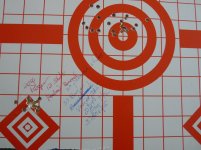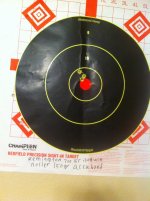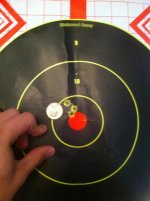Colorado Redneck
New member
I posted here a few weeks ago about a Rem SPS Varmint .204 Ruger I have. The accuracy has been less than stellar, and there were lots of good suggestions and comments. In a nutshell, I was thinking the barrel would foul and after 3-4 rounds the group would open up. So I would thoroughly clean the bore by brushing and swabbing etc. Was disappointing to say the least.
Well, the last trip to the range, that rifle went along, with a hundred rounds. My thought was, I am going to shoot the heck out of the thing, as if this were in a well populated prairie dog town. If it doesn't work my way, then maybe firelapping would be next So here is a picture of the target. I started on the bullseye in the middle. First two rounds were pretty good--then the group opened up and as you can see, it went to about 3 inches, which ain't my idea of OK. After about 10 more rounds, the hits went back toward the intended point of impact. After a few more that were hitting pretty nice, I moved to the lower left diamond on the trarget. As you can see, out of 12 shots fired, 11 were less than one inch. That is acceptable, since over 12 shots I am probably most of the cause of that size group.
The moral of this story: cleaning the barrel may be over rated. I think maybe brushing is the culprit. Art Eatman posted on a thread about how he has a rifle with a few thousand rounds through it that he has seldom used a brush on.
Anybody else experience anything like this?
Well, the last trip to the range, that rifle went along, with a hundred rounds. My thought was, I am going to shoot the heck out of the thing, as if this were in a well populated prairie dog town. If it doesn't work my way, then maybe firelapping would be next So here is a picture of the target. I started on the bullseye in the middle. First two rounds were pretty good--then the group opened up and as you can see, it went to about 3 inches, which ain't my idea of OK. After about 10 more rounds, the hits went back toward the intended point of impact. After a few more that were hitting pretty nice, I moved to the lower left diamond on the trarget. As you can see, out of 12 shots fired, 11 were less than one inch. That is acceptable, since over 12 shots I am probably most of the cause of that size group.
The moral of this story: cleaning the barrel may be over rated. I think maybe brushing is the culprit. Art Eatman posted on a thread about how he has a rifle with a few thousand rounds through it that he has seldom used a brush on.
Anybody else experience anything like this?



